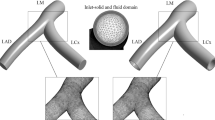Abstract
Blood flow following Carreau-Yasuda viscosity model at steady-state through various categories of stenotic arterial bifurcations based on Movahed [1] was investigated by using finite element method. Reynolds number was fixed at 233. Results are reported in terms of Wall shear stress (WSS) and velocity distributions. The maximum peaks of WSS were found at the minimum flow area, where high velocities were present. Symmetric stenotic sites give rather symmetric WSS distribution and symmetric velocity profile, whereas on asymmetric sites, the skewness depends upon the presence of the stenotic site as it introduces curvature. Volumetric flow rate ratios at various locations were introduced to indicate the crucial conditions. In addition, levels of stenosis between 30-60 % based on flow area were considered. The 60 % level gave significantly higher WSS peak and the lowest WSS at the location behind the stenosis for the symmetric case. For the asymmetric case, the 50 and 60 % levels show the lowest WSS values at the end of the stenotic site.
Similar content being viewed by others
References
M. R. Movahed, Coronary artery bifurcation lesion classification, interventional technique and clinical outcome, Expert Rev. Cardiovasc Ther., 6 (2) (2008) 261–274.
B. M. Johnston, P. R. Johnston, S. Corney and D. Kilpatrick, Non-Newtonian blood flow in human right coronary arteries: Steady state simulations, J. Biomechanics, 37 (2004) 709–720.
F. J. H. Gijsen, F. N. van de Vosse and J. D. Janssen, The influence of the non-Newtonian properties of blood on the flow in large arteries: steady flow in a carotid bifurcation model, J. Biomechanics, 32 (1999) 601–608.
I. Husain, C. Langdon and J. Schwark, Non-Newtonian pulsatile blood flow in a modeled artery with a stenosis and an aneurysm, Rec. Res. Envi. Geo. Sc., 413-418 ISBN: 987-1-61804-110-4.
N. Bernard, D. Coisne, E. Donal and R. Perrault, Experimental study of laminar blood flow through an artery treated by a stent implantation: Characterisation of intra-stent WSS, J. Biomechanics, 36 (2003) 991–998.
S. Z. Zhao, X. Y. Xu, A. D. Hughes, S. A. Thom, A. V. Stanton, B. Ariff and Q. Long, Blood flow and vessel mechanics in a physiologically realistic model of a human carotid arterial bifurcation, J. Biomechanics, 33 (2000) 975–984.
Q. Long, X. Y. Xu, B. Ariff, S. A. Thom, A. D. Hughes and A. V. Stanton, Reconstruction of blood flow patterns in a human carotid bifurcation: A combined CFD and MRI study, J. Magn. Reson. Imag., 11 (2000) 229–311.
J. Chen and X.-Y. Lu, Numerical investigation of the non-Newtonian blood flow in a bifurcation model with a nonplanar branch, J. Biomechanics, 37 (2004) 1899–1911.
J. Chen and X.-Y. Lu, Numerical investigation of the non-Newtonian pulsatile blood flow in a bifurcation model with a non-planar branch, J. Biomechanics, 39 (2006) 818–832.
E. S. Weydahl and J. E. Moore Jr., Dynamic curvature strongly affects wall shear rates in a coronary artery bifurcation model, J. Biomechanics, 34 (2001) 1189–1196.
M. Prosi, K. Perktold, Z. Ding and M. H. Friedman, Influence of curvature dynamics on pulsatile coronary flow in a realistic bifurcation model, J. Biomechanics, 37 (2004) 1767–1775.
F. J. H. Gijsen, E. Allanic, F. N. van de Vosse and J. D. Janssen, The influence of the non-Newtonian properties of blood on the flow in large arteries: Unsteady flow in a 90o curved tube, J. Biomechanics, 32 (1999) 705–713.
D. Wang and J. Bernsdolf, Lattice Boltzmann simulation of steady non-Newtonian blood flow in a 3D generic stenosis case, Computers and Mathematics with Applications, 58 (2009) 1030–1034.
A. S. Shuib, P. R. Hoskins and W. J. Easson, Flow regime characterization in a deseased artery model, World Academy of Science, Engineering and Technology, 38 (2010) 100–104.
S. Hyun, C. Kleinstreuer and J. P. Archie Jr., Hemodynamics analyses of arterial expansions with implications to thrombosis and restenosis, Med. Eng. Phy., 22 (2000) 13–27.
M. M. Zarandi, R. Mongrain and O. F. Bertrand, Determination of flow conditions in coronary bifurcation lesions in the context of the Medina classification, Modelling and Simulation in Engineering(2012).
K. Yasuda, R. C. Armstrong and R. E. Cohen, Shear-flow properties of concentrated solutions of linear and branched polystyrenes, Rheol. Acta., 20 (1981) 163–178.
E. Holzbecher and H. Si, Accuracy tests for COMSOL and Delaunay meshes, Excerpt from the Proceedings of the COMSOL Conference, Hanover, Germany(2008).
J. Boyd, J. M. Buick and S. Green, Analysis of the Casson and Carreau-Yasuda non-Newtonian blood models in steady and oscillatory flows using the lattice Boltzmann method, Phys. Fluids, 19 (2007) 093103.
Author information
Authors and Affiliations
Corresponding author
Additional information
Recommended by Associate Editor Donghyun You
K. Kanokjaruvijit is an Associate Professor in Mechanical Engineering at Naresuan University, Phitsanulok, Thailand. She received her Ph.D. from Imperial College, London. Her research interests include hemodynamics, nanofluid jet impingement and green building technology.
J. Siripokharattana’s research interest in Biomedical engineering involves lung mechanics, hemodynamics, prosthesis and orthosis. After completing an M.S. in Mechanical Engineering from Naresuan University, Mr. Jirasak joined King Mongkut’s University of Technology North Bangkok at Rayong Campus.
Rights and permissions
About this article
Cite this article
Kanokjaruvijit, K., Donprai-on, T., Phanthura, N. et al. Wall shear stress and velocity distributions in different types of stenotic bifurcations. J Mech Sci Technol 31, 2339–2349 (2017). https://doi.org/10.1007/s12206-017-0430-8
Received:
Revised:
Accepted:
Published:
Issue Date:
DOI: https://doi.org/10.1007/s12206-017-0430-8




